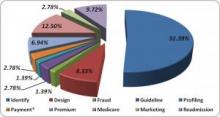A Survey of Predictive Modeling

MCOL, Payers & Providers, and Predictive Modeling News jointly sponsored a survey of health plan and healthcare professionals conducted by MCOL on their prioritization of predictive modeling activities. Survey participants typically have a more active interest in predictive modeling issues. This is the sixth annual survey in this regard, allowing the current results to be compared to responses in prior years. An exclusive report on the survey findings follows.
Participants were asked to respond to two items:
1. Categorize your organization
• Provider
• Payer
• Vendor or Other
2. Suppose you had to prioritize how an organization could spend its funds on predictive modeling initiatives involving health benefits, and you were given a list of 10 items to prioritize. How would you rank them? (1= highest priority / 10 = lowest priority; rank them 1 through 10)
The items to rank were as follows, with their abbreviated version indicated in parentheses:
• Identification of High-Risk Patients for Care Management (Identify)
• Plan Design Development (Design)
• Fraud Prevention (Fraud)
• Treatment Guideline Development (Guideline)
• Provider Profiling for Network Development (Profiling)
• Provider Payment Rate and Restructuring (Payment)*
• Premium Rate Development (Premium)
• Medicare / Medicaid Population Financial Modeling (Medicare)
• Target Marketing Based on Customer / Prospect Risk Scores (Marketing)
• Readmission Prediction Initiatives (Readmissions)
Percent of respondents who rank each item as the highest priority (1/10)
Findings
For the sixth year in a row a majority of respondents, 51.4%, ranked identification of high-risk patients for care management as the highest priority for how an organization could spend its funds on predictive modeling initiatives. No other item had a significant number of respondents ranking it as the number one priority. “Medicare” was ranked as the number one priority by 12.5% of respondents, “readmissions” by 9.7% of respondents, and the design of such initiatives by 8.3% of respondents. All other items were ranked as the number one priority by fewer than 3% of respondents.
When broken down by respondent category, there were only slight changes in the priority rankings, with the exception of the afore-mentioned ‘Medicare’ (12.5% in 2013, up significantly from the 3.5% a year ago).
Average item rank (year/year)
As expected from the percentage of respondents who ranked it as the top priority, when assessing the average rank of each item, “identify” had the highest rank (lowest numerical value) with an average of 2.69. The next average highest rank for an item was “readmission,” which had an average rank of 4.62. The items with the lowest average rank (highest numerical value) were “fraud” and “premiums” at 6.83 and 6.66 respectively.
Average priority rank of items by year (2008-2013)
In comparing the average ranks of items with the percentage of respondents who ranked each item as the number one priority, there was a basic trend of a higher average rank (lower numerical value) being associated with a higher percentage of respondents who ranked the item as the number one priority for funding with a few exceptions. “Medicare,” which had the second most amount of respondents choosing it as the number one priority, along with “readmissions” and “premiums” at 9.72% and 6.94% respectively. The former had the second lowest average rank at 4.62 while the latter had the second highest average rank at 6.66.
Average item rank relative to priority
There were a few significant differences in the percent of respondents ranking each item as the number one priority year over year. The prediction of fraud declined from 8.05% of respondents ranking it as the number one priority in 2012 to 1.39% of respondents ranking it as the number one priority in 2013. Concurrently, premium predictions became a greater concern, increasing threefold from 2.30% of respondents ranking it as the number one priority in 2012 to 6.94% of respondents ranking it as the number one priority in 2013. A fourfold increase was reported in the Medicare category as 12.5% of respondents ranked it as the number one priority in 2013 compared to a relative low of 3.45% of respondents ranking it as the number one priority in 2012.
As the priorities for funding predictive modeling activities have remained relatively constant, as evidenced in this report, so has the interest in predictive modeling itself. It will continue to provide an important risk assessment and adjustment process that applies available data.






